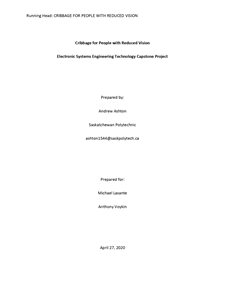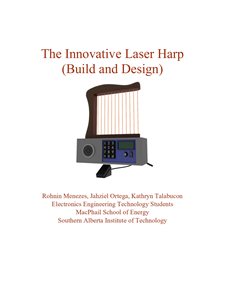2020 Technology Report Contest
2020 Technology Report Contest Winners
Awarded the top prize of $1,000 is Andrew Ashton, a graduate of the Electronic Systems Engineering Technology at Saskatchewan Polytechnic. Andrew’s project, titled “Cribbage for People with Reduced Vision”, utilizes technology to replace a traditional wooden cribbage board with a combination of electronic devices which aids players with reduced vision capabilities. With large-character, backlit LCD displays and large, colour-coded buttons, each player uses a handheld, wireless controller to enter points scored throughout the game and to view the current score of each player.
“Over the past few years, I noticed that some of my older relatives having trouble seeing the very small parts and markings on the cribbage board”, notes Andrew. “I felt I could provide a solution and hope to produce a marketable version in the future, which will make cribbage available to those who may otherwise not be able to play”.
.png.aspx?width=450&height=300)
“I was very pleased, though not surprised, Andrew won the 2020 Technology Report Contest” comments Chris Roslinsky, E.I.T., Electronic Systems Engineering Technology Program Head. “Andrew was a very hard working student with a great work ethic and dedication to his studies”.
The team of Aida Tribinevicius, Aaron Froc, Larissa Lau and Morgan Scott from the Forest and Natural Areas Management program at British Columbia Institute of Technology, with their report “Invasive Plant Species Survey And Mapping In District Of North Vancouver Parkland”, collects the second place prize of $500.
The $300 third prize is taken home by the team of Rohnin Menezes, Jahziel Ortega and Kathryn Talabucon from the Electronics Engineering Technology program at Southern Alberta Institute of Technology, with their report titled “The Innovative Laser Harp”.
The contest, open to TAC and CTAB (Canadian Technology Accreditation Board) national accredited programs, saw a record number thirty-three entries. Discipline specific judging panels, comprising of certified engineering technology and applied science technician and technologists with audit experience, evaluated each technology report. The top two reports were assessed by a final judging panel of three certified professionals, each with extensive education, industry and audit backgrounds. Reports were examined for their originality, complexity, academic rigor, innovation and presentation.
The judges acknowledge that the technology reports clearly demonstrate proficiency in the students’ approach, evaluation and development of solutions to actual industry challenges. Furthermore, the reports are evidence of the quality education and training offered by educational institutions in these nationally accredited programs.
Each of the final judges agreed it was an intellectual treat to read the reports, learn new information and appreciate how the students have been prepared to tackle present and future challenges in their area of expertise. In addition to capable students and a strong project topic, the judges commended faculty members for their mentorship as an important ingredient to the winning reports.
“We are very pleased to have continued the Technology Report Contest, a wonderful legacy from CTAB”, remarks Richard Stamper, TAC Executive Director. “The contest provides a great opportunity to showcase the incredible student talent produced from national accredited programs.”
1st Place 2nd Place 3rd Place



2020 Technology Report Contest Details
Eligibility: One Technology Report submission per TAC or CTAB accredited program, written by one student or in a group up to four students, in their final year of their program
Report Criteria: Produce a written, minimum 3,000 word Technology Report, following general learning outcome GY01 Technology Report, which includes research, design, testing, analysis and conclusions related to a significant technology-related issue
Judging Criteria
| Category |
Particulars |
Grading |
| Originality |
IIncludes independent and creative in thought |
15% |
| Complexity |
Includes complicated or interrelated parts |
25% |
| Academic rigor |
Follows general learning outcome indicators for GY01 Technology Report |
15% |
| Innovation |
Introduces a new idea, method or device |
15% |
| Conclusions/Recommendations |
Supported by research, analysis and are justified |
10% |
| Presentation/Format |
Uses accepted principles of documentation, grammar, writing style, graphics and design |
20% |